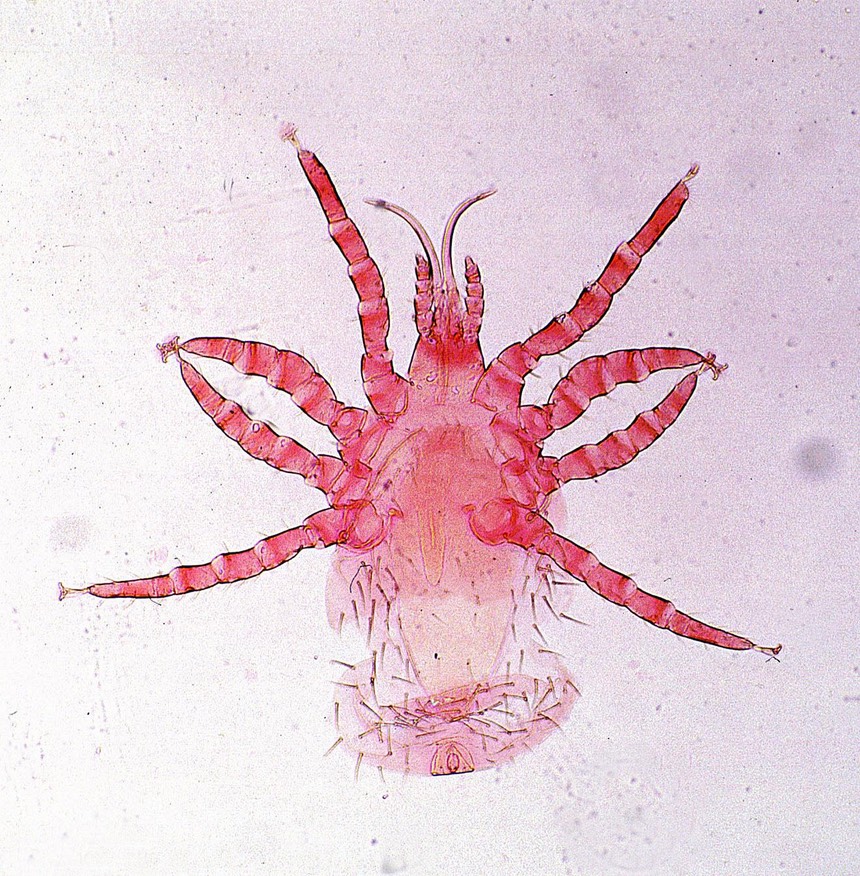Many kinds of mites blood feed upon birds and rodents. Some kinds spend considerable time on their hosts, and others tend to remain in the host’s nest when not feeding. These mites may become impressively abundant in and around the nest or roost site, and they may pose significant irritation to their hosts. A few of these mites may stray and happen upon a person or pet. When this happens, and if the mite is hungry, it may attempt to feed. For some people, the bites may go unnoticed. For others, the bite may be immediately detected, but the mite (because of its diminutive size) may be hidden in plain sight. Often, a person may not be aware of the encounter until some time later, when a tissue reaction – or an infection – may ensue. By then, the villain is long gone, and the person is left to try to ‘connect the dots’; that is, attempt to ascribe a cause (guess) to the insult.
Visits to clinicians or by pest control operators rarely help solve the mystery. It is often mistakenly assumed that the villains are bed bugs, and the home is then treated for those pests. The strategies to abate bed bugs, however, are far different – and often unsuccessful – when biting mites are the true culprits. The patient him/herself, the patient’s family, physician, work associates and other acquaintances may then begin to question the mental stability of the patient, and offer that person a wide berth. Some of these cases can be resolved by finding the actual villains. Sadly, other complainants may be burdened with yet other maladies that have nothing at all to do with mites, whether biting or otherwise. In each case, the affected person should be treated with compassion, offered support and referred for appropriate guidance.
Diverse kinds of mites may bite or attack for just fleeting moments. Some attempt to blood feed and others may simply be sampling the substrate (the skin in this case) and be surprised that they’ve just tasted something unwanted.
Blood-feeders
Mites that normally blood feed upon birds and occasionally pester people mainly include the chicken mite or ‘red mite of poultry’ (Dermanyssus gallinae), the northern fowl mite (Ornithonyssus sylviarum) and the tropical fowl mite (Ornithonyssus bursa). Because these mites can pose health burdens to birds and cause irritation to handlers, poultry workers are usually well aware of these mites. Bird mites also affect members of the general public who reside or work within structures on which diverse kinds of birds may nest or roost. Pigeons, sparrows, starlings and many other kinds of birds frequenting a building may thereby introduce and host thriving populations of these mites. The mites will bite people and pets, but will fail to thrive without their preferred hosts. Owners of pet birds may discover that their feathered friend is also attacked by the mites and may even support a thriving and perpetuating population. In the absence of birds, the population of mites will generally decline within weeks.
Mites that normally blood feed upon rodents and periodically attack people mainly include the house mouse mite (Liponyssoides sanguineus) and the tropical rat mite (Ornithonyssus bacoti), but others occasionally cause annoyance. As the name suggests, the house mouse mite is mainly associated with the house mouse, but they also feed on rats. These hosts are frequent denizens of homes and apartments, particularly in urban areas. House mouse mites will bite people and pets, but will not persist without their rodent hosts. In addition to the irritation resulting from their bites, these mites occasionally transmit the pathogen that causes the disease rickettsialpox in people. Isolated cases of this disease occur from time to time, but transmission becomes far more intense when there are significant sanitation issues (that promote mouse and rat abundance, and also their mites). Massive accumulations of trash – and blossoming populations of rodents - that have resulted from strikes by sanitation workers have promoted outbreaks of this infection.
Despite the name, the tropical rat mite is not restricted to the tropics. It is a fairly common ectoparasite of rodents throughout North America, and is frequently encountered in urban areas. This mite will stray from its preferred host to feed on people, and is a frequent cause of rat-mite dermatitis worldwide. Neither the tropical rat mite nor the house mouse mite will thrive in the absence of their rodent hosts. Their populations will tend to drop within weeks after their hosts are eliminated.

